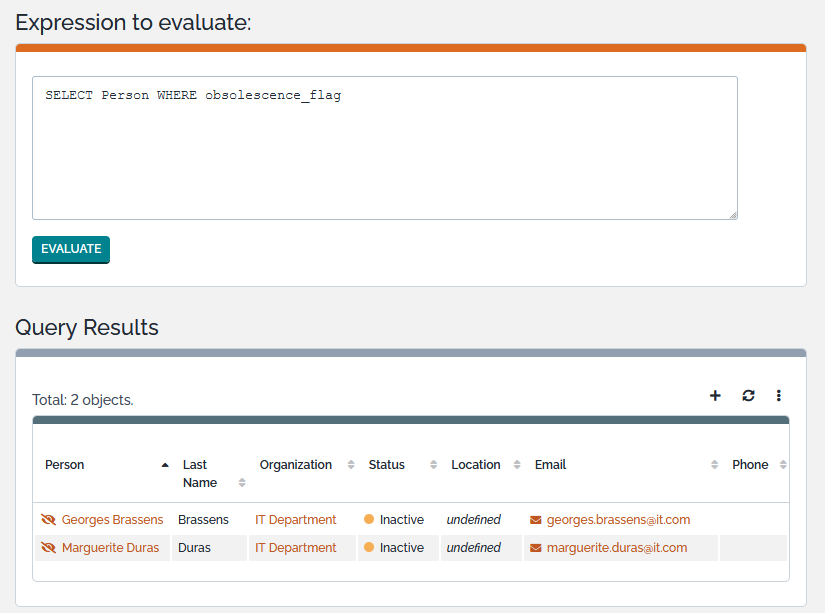Obsolescence
Introduced by iTop 2.4, the Data Model now includes an obsolescence notion defined per class of object, to improve user experience by highlighting / hiding obsolete objects.
-
See user impact of obsolescence in the User Guide.
-
For configuring your own obsolescence rules check the tutorial: Define Obsolescence rules
Searching for obsolete objects
Use RunQuery and automatic
attribute
obsolescence_flagBe cautious to set User
Preference
show obsolete data before running the
query, otherwise the query won't return anything!- Run Query
-
SELECT Person WHERE obsolescence_flag

Limitations
The
obsolescence_flag field is based on a OQL expression.
It is calculated only when reading the object from
database. It's not taking into account
not-yet-saved object modifications, which should logically
affect it.obsolescence_date
won't be documented unless the iTop cron is running.This is done in background as an asynchronous task
User Portal never takes into
account the user preferences, so obsolete data are visible unless
filtered by portal scopes
Default obsolescence rules
Which objects are Obsolete?
In general:
-
Objects with a status equal to
obsoleteorinactive -
Objects being a sub-object of another one, are obsolete if their main object is. Example: Physical Interface is obsolete if its ConnectableCI is. There are two exceptions to this rule: a Virtual Machine and an Hypervisor are obsolete if and only if their own status is
obsolete -
License expired more than 15 months ago, (Search query cannot be cached, so cautious with high volumes)
If you want to notify
obsolete contacts, be aware that this will fail if the
user chose to hide obsolete objects in his preference
Configuration Management core
-
Contact:
status='inactive' -
Document:
status='obsolete'
CIs
-
Application Solution:
status='inactive' -
Business Process:
status='inactive' -
DB Server:
status='inactive' -
Database Schema:
its DBServer is obsolete -
Middleware:
status='inactive' -
Middleware Instance:
its Middleware is obsolete -
Network Device:
status='obsolete' -
Other Software:
status='inactive' -
PC Software:
status='inactive' -
Server:
status='obsolete' -
Web Application:
its Web server is obsolete -
Web server:
status='inactive'
Miscellaneous
-
Group:
status='obsolete' -
Location:
status='inactive' -
OS Licence:
Licence is not perpetual and end date defined and exceeded by more than 15 months -
OS Patch: no obsolescence defined
-
Organization:
status='inactive' -
Physical Interface:
its Device is obsolete -
Software: no obsolescence defined
-
Software Licence:
Licence is not perpetual and end date defined and exceeded by more than 15 months -
Software Patch: no obsolescence defined
-
Subnet: no obsolescence defined
-
VLAN: no obsolescence defined
End User devices
On all end-user devices use the same logic defined on Physical
Device: status='obsolete'
Virtualization Management
-
Farm:
status='obsolete' -
Hypervisor:
status='obsolete' -
Logical Interface:
its Virtual Machine is obsolete -
Virtual Machine:
status='obsolete
Advanced Storage
-
Fiber Channel Interface:
its Datacenter Device is obsolete -
Logical Volume:
its Storage System is obsolete -
NAS:
status='obsolete' -
NAS File System:
its NAS is obsolete -
SAN Switch:
status='obsolete' -
Storage System:
status='obsolete' -
Tape:
its Tape Library is obsolete -
Tape Library:
status='obsolete'
Datacenter
-
Enclosure:
status='obsolete' -
PDU:
status='obsolete' -
Power Source:
status='obsolete' -
Rack:
status='obsolete'
Ticket
Since 2.5.0, there is no obsolescence rule on Ticket anymore as it was degrading performance
Do not use relative date
comparison in obsolescence computation rule as it prevent query
caching thus impact negatively iTop performance
3_0_0/feature/obsolescence.txt ·
Last modified: 2022/08/23 17:25 by 127.0.0.1
